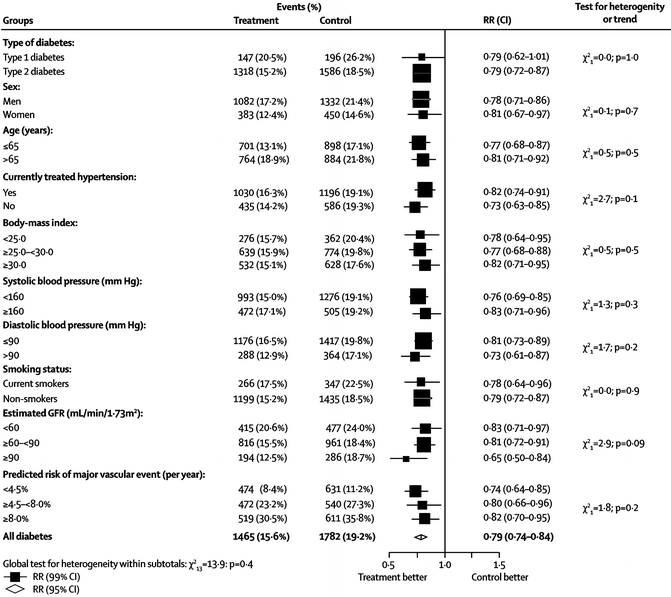Randomized clinical trial
Original publication year
Diabetic subjects (n)
Study focus group
Statin type (mg/day)
Average follow-up (years)
Primary enrollment locations
4S
1994
202
CHD
Simva 20–40
5.4
Scandinavia
WOSCOPS
1995
76
PP (men)
Prava 40
4.9
Scotland
CARE
1996
586
Post-MI
Prava 40
5
USA and Canada
Post-CABG
1997
116
CABG
Lova 2.5–80
4.3
USA
AFCAPS
1998
155
PP
Lova 20–40
5.2
USA
LIPID
1998
782
CHD
Prava 40
6.1
Australia and New Zealand
GISSI
2000
582
Post-MI
Prava 20
2
Italy
HPS
2002
5,963
High-risk
Simva 40
5.3
UK
PROSPER
2002
623
Elderly
Prava 40
3.2
Scotland, Ireland, Netherlands
ALLHAT
2002
3,638
HTN
Prava 20–40
4.8
USA and Canada
LIPS
2002
202
Post-PCI
Fluva 80
3.9
Europe, Canada, Brazil
ASCOT
2003
2,527
HTN
Atorva 10
3.3
UK, Ireland, Nordic countries
ALERT
2003
396
Renal Txp
Fluva 40
5.1
Europe, Canada
CARDS
2004
2,838
DM
Atorva 10
4
UK and Ireland
During an average follow-up of 4.3 years, 3,247 major vascular events occurred in diabetic patients. All-cause mortality was reduced by 9 % per 1 mmol/L reduction in LDL-C in diabetic patients (RR 0.91 [99 % CI 0.82–1.01], p = 0.02), which was similar to patients without diabetes. As expected, the mortality reduction was attributable to lower vascular mortality (RR 0.87 [99 % CI 0.76–1.00], p = 0.008) with no effect on nonvascular mortality. Major vascular events were reduced by 21 % per 1 mmol/L reduction in LDL-C (RR 0.79 [99 % CI 0.72–0.86], p < 0.0001). Individually, each component endpoint was reduced: myocardial infarction or coronary death (RR 0.78 [99 % CI 0.69–0.87], p < 0.0001), coronary revascularization (RR 0.75 [99 % CI 0.64–0.88], p < 0.0001), and stroke (RR 0.79 [99 % CI 0.67–0.93], p = 0.0002). Findings were not dependent on pre-treatment lipoprotein parameters and there was no threshold below which benefit was absent. The proportional therapeutic benefits of statins in diabetic patients were also similar irrespective of type of diabetes, sex, age, hypertension, body mass index, smoking, kidney disease, or overall risk category (Fig. 18.1).


Fig. 18.1
Proportional effects on major vascular events per mmol/L reduction in LDL cholesterol by baseline subgroups in diabetic patients. Rate ratios (RRs) are plotted comparing outcome in participants who were allocated statin treatment to control, along with their CIs. The area of each square is proportional to the amount of statistical information in that particular category. Diamonds or squares to the left of the solid line indicate benefit with treatment, which is significant (i.e., p < 0.05 and p < 0.01, respectively) if the diamond or horizontal line does not overlap the solid line. The RRs are weighted to represent the reduction in the rate per 1 mmol/L LDL cholesterol reduction achieved by treatment at 1 year after randomization. GFR = glomerular filtration rate. Figure reproduced with permission from Elsevier [13]
Putting the Evidence in Perspective
Based on the CTT meta-analysis [13], in adults who have diabetes, it was estimated that a low-potency statin would prevent approximately 45 patients per 1,000 from having a major vascular event over five years. Given that high-potency statins are roughly two and one-half times as effective as low potency ones, a high-potency statin prevents approximately 113 patients per 1,000 from having a major vascular event over 5 years with a number needed to treat (NNT) of 9. This is approximately half the 5-year number needed to treat of 20 for a major vascular event found in the Justification for the Use of statins in Prevention: An Intervention Trial Evaluating Rosuvastatin (JUPITER) trial [14], a primary prevention trial of a potent statin, rosuvastatin 20 mg daily, that excluded diabetic patients. Economic analyses of randomized trials, including the HPS [15], have shown statin therapy is cost-effective, if not cost saving, for a wide range of diabetic patients.
Implementing the Evidence in Practice
In the Steno-2 study, investigators from Denmark randomly assigned 160 patients with type 2 diabetes and microalbuminuria to a multifactorial intervention (lipid-lowering therapy, aspirin, renin-angiotensin inhibition, and tight glucose control) versus conventional therapy [16]. The study completed follow-up in 2006 after a mean duration of treatment of 7.8 years and additional mean observation period of 5.5 years. During the intervention phase, 85 % of the treatment group took statins (mean attained LDL-C 83 mg/dL from 133 mg/dL at baseline) compared with 22 % of the conventional therapy group (mean attained LDL-C 126 mg/dL from 137 mg/dL at baseline). More than eight in ten patients in both groups went on to take statins in the observation phase with mean LDL-C concentrations converging near 70 mg/dL; however, survival curves continued to diverge.
Upon completion of follow-up, compared with 40 deaths in the conventional therapy group, only 24 patients who received multifactorial intervention died (hazard ratio 0.54 [95 % CI 0.32–0.89], p = 0.02). Multifactorial intervention reduced cardiovascular mortality (hazard ratio 0.43 [95 % CI 0.19–0.94], p = 0.04) and cardiovascular events (hazard ratio 0.41 [95 % CI 0.25–0.67], p < 0.001). Even with imperfect implementation (proportion of patients achieving ideal treatment targets was modest), the NNTs over the full study period (7.8 years of intervention and an additional 5.5 years of follow-up) were impressively low: three patients to prevent one cardiovascular event, five patients to prevent death from any cause, and eight patients to prevent a cardiovascular death. It was concluded that statins and antihypertensive therapies were the two most influential therapies in reducing risk. In sum, Steno-2 demonstrates that early implementation of statin therapy as part of a multifaceted approach to risk reduction achieves dramatic reductions in absolute risk, and thus low numbers needed to treat, making primary prevention strategies incorporating statin therapy in diabetic patients second to few if any other medical therapies in modern medicine.
Stay updated, free articles. Join our Telegram channel

Full access? Get Clinical Tree








